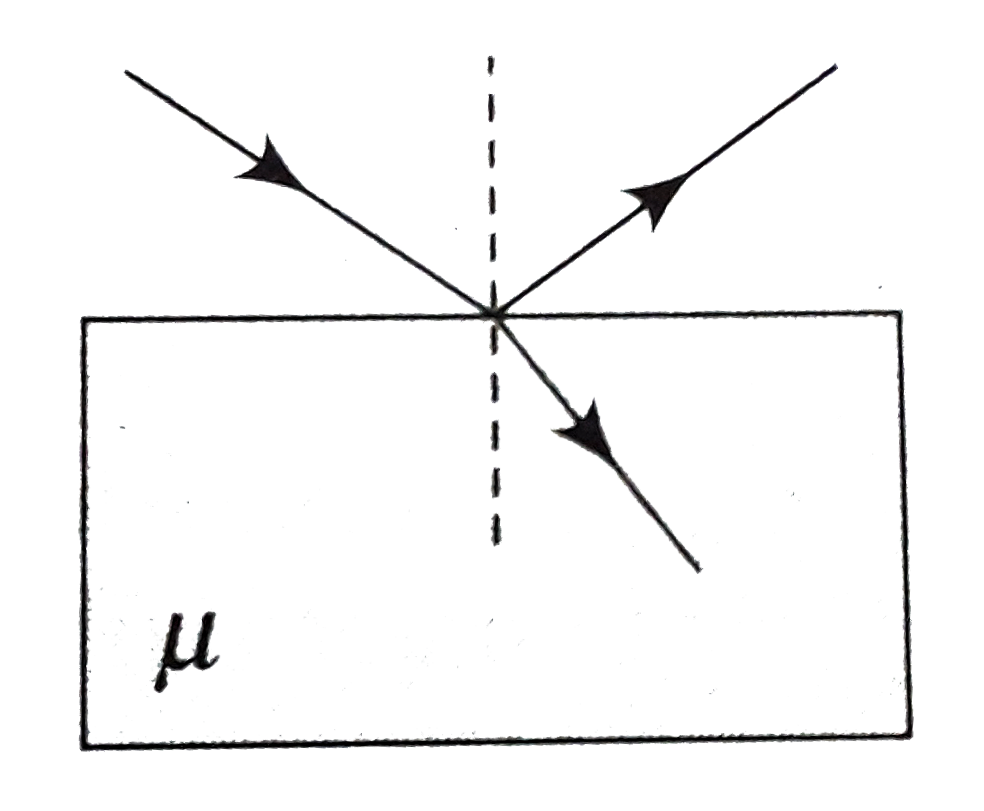Unpolarized light is incident on a plane glass surface. What should be the angle of incidence so that the reflected and refracted rays are perpendicular to eachother ?
To solve the problem of finding the angle of incidence so that the reflected and refracted rays are perpendicular to each other when unpolarized light is incident on a plane glass surface, follow these steps:
1. Understanding the Problem: We need to find the angle of incidence (denoted as I) at which the reflected ray and the refracted ray are perpendicular to each other. This means that the angle between these two rays is 90∘.
2. Using the Condition for Perpendicular Rays: The condition for the reflected and refracted rays to be perpendicular is that the angle of incidence should be equal to the polarizing angle (Ip).
3. Refractive Index: We are given that the refractive index (μ) of glass is 1.5.
4. Polarizing Angle Formula: The polarizing angle can be calculated using the formula:
tan(Ip)=μ
where μ is the refractive index of the medium (glass in this case).
5. Substituting the Refractive Index: Substituting the value of the refractive index into the formula:
tan(Ip)=1.5
6. Calculating the Polarizing Angle: To find Ip, we take the arctangent (inverse tangent) of 1.5:
Ip=tan−1(1.5)
7. Finding the Value: Using a calculator or trigonometric tables, we find:
Ip≈56.3∘
8. Conclusion: Therefore, the angle of incidence I that makes the reflected and refracted rays perpendicular is:
I=56.3∘
Final Answer:
The angle of incidence should be 56.3∘.
---
tan(Ip)=μ
where μ is the refractive index of the medium (glass in this case).
tan(Ip)=1.5
Ip=tan−1(1.5)
Ip≈56.3∘
I=56.3∘
The angle of incidence should be 56.3∘.
Topper's Solved these Questions
Similar Questions
Knowledge Check
- Question 1 - Select One
Unpolarized light is incident on a plane glass surface. The angle of incidence so that reflected and refracted rays and perpendicular to each other, then
Ataniβ=μ2Btaniβ=μCsiniβ=μDcosiβ=μ - Question 2 - Select One
A ray of light in incident on a glass plate at an angle of 60∘. What is the refractive index of glass if the reflected and refracted rays are perpendicular to each other?
A12B√32C32D√3
A light ray is incident normally on a plane mirror.
What is its angle of incidence?View SolutionUnpolarised light is incident from air on a plane surface of a material of refractive index .μ.. At a particular angle of incidence .I., it is found that the reflected and refracted rays are perpendicular to each other. Which of the following options is correct for this situation?
View SolutionUnpolarised light is incident from air on a plane surface of a material of refractive index μ. At a particular angle of incidence i, it is found that the reflected and refracted rays are perpendicular to each other. Which of the following options is correct for this situation?
View SolutionA : When an unpolarised light is incident on a glass plate at Brewster angle, the reflected ray and refracted ray are matually perpendicular.
R : The refractive index of glass is equal to sine of the angle of polarisation.View SolutionA ray of light is incident on a glass sphere of refractive index 3/2. What should be the angle of incidence so that the ray which enters the sphere does not come out of the sphere ?
View SolutionStatement I: A light ray is incident on a glass slab. Some portion of it is reflected and some is refracted. Refracted and reflected rays are always perpendicular to each other.
Statement II: Angle of incidence is equal to angle of reflection.
 View Solution
View Solution

